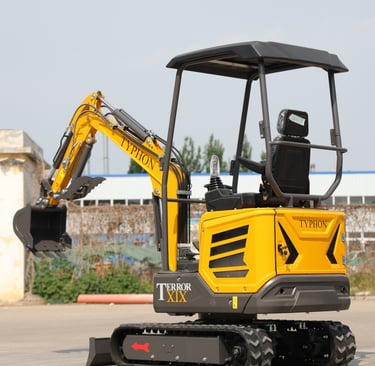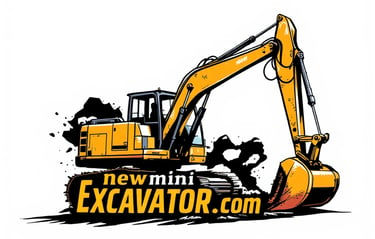How to Dig a Trench with a Mini Excavator
9/20/20247 min read


```html
Key Takeaways
Digging a trench with a mini excavator requires a systematic approach to ensure efficiency and safety. By adhering to a structured process, you can leverage the capabilities of a mini excavator to achieve optimal results in your trenching projects. Let's highlight the essential steps and best practices involved.
First, preparation is crucial. Prior to commencing the trenching work, it is important to conduct a thorough site assessment. This includes identifying underground utilities, marking the trench path, and ensuring you have the necessary permits. Proper site preparation lays the foundation for a successful excavation project.
Operational techniques play a pivotal role in the trenching process. Mastering the controls of the mini excavator is essential for precision. Start by positioning the excavator correctly and use the boom and stick to dig along the marked path. Ensure you maintain a consistent depth and width throughout the trench. Furthermore, employing a trenching bucket can enhance the efficiency and accuracy of your work.
Soil management is another key component. Handling the excavated soil properly ensures a clean and organized work site. Use the mini excavator to deposit the soil at a designated location, away from the trench edges to prevent collapses. Good soil management practices contribute to project efficiency and safety.
Advanced tips can further enhance your trenching projects. For example, keeping the excavator's engine in optimal condition, regularly inspecting hydraulic systems, and using appropriate personal protective equipment are all critical measures. Additionally, attending training sessions on advanced digging techniques can provide valuable insights and improve your operational expertise.
In understanding these key takeaways, one can appreciate the versatility and efficiency of using a mini excavator for trenching. The detailed preparation, adept operation, efficient soil management, and advanced tips collectively contribute to achieving successful outcomes in your excavation projects.
``````htmlPreparation
Proper preparation is a fundamental aspect of trenching with a mini excavator, ensuring both the safety and efficiency of the project. The initial step involves a thorough assessment of the job site. This includes a comprehensive examination of the terrain and environmental conditions, identifying potential obstacles that might hinder the trenching process. Additionally, understanding the soil composition and moisture levels can be crucial in determining the appropriate trenching techniques and tools.
Acquiring the necessary permits is another critical preparatory measure. Depending on the location and the scale of the project, several permits might be required from local regulatory authorities. These permits ensure that the trenching work complies with regional, state, and federal regulations, thereby avoiding legal complications.
Marking the trench path accurately is essential to guide the trenching work. Utilizing stakes or spray paint to outline the proposed trench path can provide clear visual markers, helping to maintain straight lines and consistent trench depth. This step not only aids in precision but also prevents deviations that could compromise the project's integrity.
Before commencing any excavation work, it is imperative to contact utility companies to locate and mark any underground services. This includes gas, water, electricity, and telecommunications lines. By ensuring all underground utilities are identified and marked, potential hazards such as service disruptions or accidents can be significantly mitigated.
Lastly, verifying that the mini excavator is in excellent working condition is crucial. This encompasses a thorough inspection of the machine’s engine, hydraulic systems, tracks, and other components. Ensuring regular maintenance checks and addressing any mechanical issues beforehand can prevent unexpected breakdowns and enhance the overall efficiency and safety during the trenching operation.
Adhering to these preparatory steps not only aligns with best practices but also establishes a solid foundation for a successful trenching project with a mini excavator.
```How to Dig a Trench with a Mini Excavator
Digging a trench with a mini excavator involves a series of precise steps to ensure efficiency and safety. Start by positioning the mini excavator at the trench's starting point. Ensure the machine is stable by spreading the tracks to their maximum width and setting the blade down for additional stability.
The next step is selecting the appropriate bucket size. The width and depth of your trench will determine the bucket size. Typically, buckets range from 12 to 24 inches. A narrow bucket is ideal for utility lines, while a wider bucket is better for larger tasks like drainage ditches. Be sure to choose a bucket that suits your trenching needs to optimize efficiency.
Once set up, familiarize yourself with the machine's controls. Operate the joystick to control the arm and boom for precise movements. Begin digging by slowly lowering the bucket into the ground, then curl it to scoop up the dirt. Elevate the arm slightly and rotate the turret to the spoil pile to deposit the scooped material. Repeat this process until you reach the desired trench length.
While operating the mini excavator, maintaining visibility is crucial. Frequently check your surroundings to ensure no obstacles or personnel are within the working radius. Additionally, always be aware of any underground hazards, such as utility lines, by consulting relevant plans or using detection equipment if necessary.
To keep the trench aligned, use markers or guidelines as references. Frequently check your progress against these markers to ensure you’re digging a straight and accurate trench. Monitoring the trench’s depth is equally important. Use grade stakes or a depth gauge to maintain consistent depth throughout the trenching process.
Following these steps meticulously will help ensure a smooth, efficient, and safe trench digging process with your mini excavator.
Managing Excavated Soil
Handling the soil excavated from a trench is a critical aspect of any excavation project. Properly managing the soil not only maintains a tidy job site but is also essential for safety and environmental compliance. One of the first strategies is planning the soil placement before starting excavation. This foresight helps in avoiding existing obstacles or hazardous areas such as drainage systems, pathways, and utility lines.
Efficient soil management starts with choosing an appropriate location to store the excavated earth. A well-thought-out soil placement plan ensures that the soil heap does not interfere with the workflow or create hazards. The chosen location should accommodate the volume of excavated material without encroaching on work areas or causing inconvenience.
When stacking excavated soil, it is imperative to minimize soil erosion. One recommended technique is to create a gentle slope at the edges of the soil pile. This prevents soil from running off during periods of rain, which not only preserves the integrity of the stored soil but also mitigates the risk of environmental contamination. Using tarps or other coverings during inclement weather conditions further protects against erosion.
Stacking should be carried out with safety in mind. Ensure the soil is placed in a manner that it remains stable and secure. The base layer should be broad and firm to support the weight of the soil above. Checking stability periodically is a good practice. This vigilance helps in preventing collapses that could pose significant safety hazards to workers and equipment.
Another aspect of environmentally compliant soil management includes proper disposal or reuse of the excavated material. For projects where the soil cannot be reused immediately, storing it securely keeps it free of contaminants. Some projects may necessitate hauling the soil away to designated disposal sites, a step that should be planned well in advance to streamline operations.
Effective soil management is a multifaceted process incorporating careful planning, ongoing monitoring, and adherence to safety and environmental standards. By employing these techniques, the challenge of managing excavated soil becomes manageable, ensuring a safe, clean, and compliant job site.
Advanced Tips for Using Mini Excavators
For those who have accumulated some experience with mini excavators, advancing your skills to achieve greater efficiency and precision can significantly improve project outcomes. One of the first steps in elevating your mini excavator operation is to explore and utilize different attachments. Attachments such as buckets of varied sizes, augers, or hydraulic hammers can extend the functionality of the mini excavator, allowing for a broader range of tasks beyond standard trenching. It is essential to match the attachment to the specific requirements of the job to optimize performance and maintain equipment integrity.
Leveraging modern technology, such as GPS systems, has proven to be invaluable in precision trenching. These systems offer real-time, exact positioning, allowing operators to dig trenches that possess consistency in depth and direction, minimizing human error. GPS technology can be integrated into the mini excavator's control panel, providing a user-friendly interface for detailed excavation planning and execution.
Operating in tight spaces requires a refined set of advanced controls to maneuver the mini excavator with finesse. This includes mastering the machine's swing and tilt functionalities to navigate confined sites without causing damage to surrounding areas. Understanding how to use counterweights and adjusting the hydraulic flow settings can enhance stability and power management, crucial for maintaining control in restricted environments.
Maintenance practices play a critical role in keeping the mini excavator in top operational condition. Routine inspections should be performed to assess the hydraulic systems, track tension, and engine performance. Timely replacements of worn-out parts, frequent oil changes, and ensuring proper lubrication can prevent unexpected breakdowns. Additionally, familiarizing oneself with the troubleshooting of common issues, such as hydraulic leaks or engine overheating, can save time and reduce downtime.
By integrating these advanced tips into your mini excavator operations, not only is efficiency and precision enhanced, but the longevity and reliability of the machine is also assured, contributing to successful and timely project completions.
Applications of Mini Excavator Trenching
Trenching with a mini excavator offers a multitude of benefits across various industries, making it an essential tool for a wide array of projects. One of the primary applications is in the utilities sector, where mini excavators are frequently used for laying pipes and cables. Whether it's for water distribution, gas pipelines, or electrical conduits, the precision and efficiency of a mini excavator make it an ideal choice. Its compact size allows operators to maneuver in tight spaces, such as urban environments, without causing extensive disruption.
In the landscaping industry, mini excavators play a crucial role in the installation of irrigation systems and drainage solutions. Their ability to dig precise trenches ensures that water flow is effectively managed. For instance, creating trenches for irrigation systems requires accuracy to ensure that water reaches all necessary areas without wastage. Similarly, drainage systems benefit from the mini excavator's capability to create channels that efficiently direct water away from unwanted areas, mitigating the risk of waterlogging and erosion.
Construction projects also see significant advantages from using mini excavators for trenching. When it comes to laying foundations and footings, the capability to dig evenly and to the exact specifications is indispensable. Mini excavators are often employed to create trenches that serve as the groundwork for various structures, ensuring stability and structural integrity. Additionally, their versatility allows for quick adaptation to different site conditions, making them valuable assets in construction zones with diverse terrain.
The agricultural sector also leverages the benefits of mini excavator trenching. Farmers use these machines to create irrigation trenches that facilitate efficient water distribution across fields. The ability to dig shallow or deep trenches based on the specific crop needs is a distinct advantage, contributing to better crop yields and more efficient water usage. Furthermore, mini excavators help in creating drainage systems that protect crops from excessive moisture, proving their worth across farming operations.
In essence, the versatility of mini excavators is evident through their widespread use in utilities, landscaping, construction, and agriculture. Their ability to perform a variety of trenching tasks with precision and efficiency underscores their indispensable role in modern trenching projects.
Explore our wide range of mini excavators for sale.
Company
© 2024. New Digger for sale, All rights reserved.


Privacy Policy | Terms and Conditions
Follow us now
Support
For Inquiries
2522 S Malt Ave. Commerce, CA 90040
United States
Our Location
Tel:
+1-213214 2203
WhatsAp:
+1-3235325703
Mon-Fri: 9am-5pm
